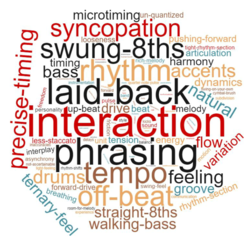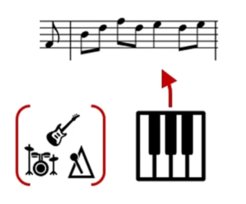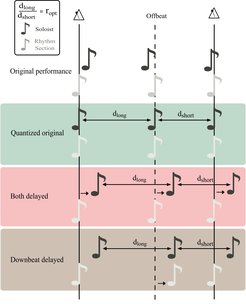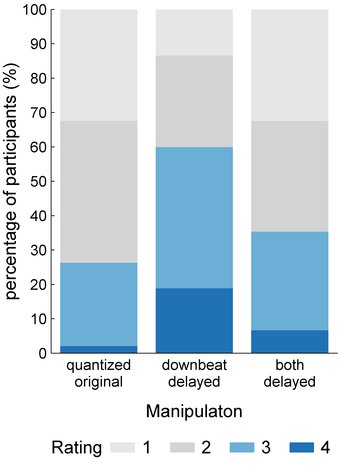
What is This Thing Called Swing?
The Role of Synchronization for the Swing Feel in Jazz
Jazz must swing - jazz musicians agree on that. However, even a century after the beginnings of jazz, there is still no general agreement what exactly constitutes the swing feel. With a dedicated experiment and data analyses on more than 450 well-known jazz solos, we have tried to unravel some secrets of swing.
(For more details, see C. Nelias et al. Downbeat delays are a key component of the swing feel in jazz [1]).
"It Don't Mean a Thing, If It Ain't Got That Swing"
The swing feel is one of the most salient features of jazz music and is considered an essential ingredient of jazz performances, as reflected e.g. in the title of Duke Ellington's jazz standard "It Don't Mean a Thing, If It Ain't Got That Swing". The notion of swing was introduced by jazz musicians to denote a specific performance style they considered essential for jazz. Yet despite its central role it is still unclear what are the main musical and psychoacoustical constituents of the swing feel. It was even argued in the past that "you can feel it but you just can’t explain it" [2], or similarly, according to The New Harvard Dictionary of Music, that swing is "an intangible rhythmic momentum in jazz ... swing defies analysis" [3].

Even today, there is still no consensus among jazz musicians as to which musical details (apart from the "swung notes") create the swing feel. This becomes apparent from the following word cloud, which summarizes the various answers that jazz musicians gave us to this question in an earlier project.
Among the possible components of swing only one is established unambiguously so far, the conspicuous unequal subdivision of quarter notes into long and short eighth notes ("swung notes"). It is measured by the so-called swing ratio, i.e., the length ratio of consecutive long and short eighth notes that are known as downbeats and offbeats.
Interactive tool: What are downbeats, offbeats, and swing ratio?

Downbeat refers to the first eighth of a quarter note, offbeat to the second eighth. Click here for our interactive tool with audio examples demonstrating downbeats and offbeats. It also allows you to explore and experience different swing ratios.
This alternation of downbeats and offbeats played at unequal lengths is an easily perceivable and generally accepted prerequisite of swing, which is not sufficient, however. Listening to computer-generated jazz music that was “swingified” by merely implementing a suitable swing ratio, it is obvious to jazz musicians that there must be other components. But which are these components, and which ones are important?
Microtiming deviations as a cause of swing?
It has long been speculated that so-called microtiming deviations (MTDs) play the dominant role for the swing feel, besides accentuation, syncopation, and phrasing. However, while the importance of the swing ratio is generally accepted, the role of rhythmic microtiming deviations has been a subject of controversy for many decades. Various authors have emphasized the importance of participatory discrepancies; i.e. "little discrepancies within a jazz drummer’s beat, between bass and drums, between rhythm section and soloists, that create ’swing’ and invite us to participate" [4]. Others contested their influence and rather stressed the importance of rhythmic accuracy. Many of these claims were based on analyses of extracts from individual jazz musicians, which may explain the origin of the controversial claims, as MTDs are not used equally by all musicians. It is not clear, however, that MTDs - even if they occur - are specifically related to and enhance the swing feel. Is there a way to prove that MTDs do contribute substantially to the swing feel?
If jazz musicians can feel it, but not explain it precisely, we should be able to characterize the role of microtiming deviations by having experienced jazz musicians evaluate recordings in which we manipulated the microtiming in various ways. Adopting an operational definition of swing (i.e., the performance of a piece swings if it is judged as swinging by expert listeners) and using an experimental approach, we were able to clarify the controversy and to rigorously demonstrate a positive effect of certain systematic MTDs on swing. In a preceding study of our research group we found that involuntary random MTDs did not enhance swing [5], as quantized versions (without MTDs) of 12 different jazz pieces were rated highest by listeners. The question remained open, whether systematic MTDs play a role for the swing feel.
Our approach [1]

1. Recording of pieces
We recorded jazz standard pieces (Serenade to a cuckoo, Jordu, and others) played by a professional pianist on a MIDI keyboard. While the pianist was playing, he heard a quantized track with bass and drums via headphones (without microtiming deviations), which not only provided the accompaniment, but also took on the function of a metronome. In addition we used two pieces (The smudge and Texas blues) performed by Miles Black on the PG music “Oscar Peterson multimedia CD”.
2. Systematic manipulation of the recordings

We prepared audio extracts presenting different kinds of systematic MTDs in jazz piano performances (“soloist”) with respect to the quantized rhythm section (“rhythm section”). The manipulations we carried out on real performances are sketched in the figure. Two downbeats are indicated by metronomes and vertical full lines, the offbeat in between by a dashed vertical line. The onset timing of the rhythm section is denoted by light gray notes, the onset timing of the soloist by black notes. We based all manipulations on a quantized original version, which aligns the notes to a grid with an optimized swing ratio. We needed to take such a step for the sake of providing well-controlled distinguishable conditions. We think that this is justified as a minor intervention as we previously showed that random microtiming fluctuations do not play a positive role for swing [5]. For the present experiment, we hypothesized that a positive effect on swing might result from:
- a both delayed manipulation, where all notes of the soloist are uniformly delayed with respect to the rhythm section, and/or
- a downbeat delayed manipulation, where the soloist notes are delayed apart from the offbeats (which are synchronized with the rhythm section). This manipulation was devised in a way that leaves the soloist's swing ratio unchanged, in order to avoid a separate effect of the swing ratio on the swing ratings.

3. Experiment investigating swing
We presented the manipulated audio extracts to professional and semiprofessional jazz musicians in an online experiment. Participants were asked to compare all three manipulations with each other and to respond to the questions “Did it swing?” and “Did it groove?” for each piece separately. Answers were given on a scale from 1 (“not at all”) to 4 (“very much”). The results show that professional and semiprofessional jazz musicians gave the highest swing ratings to versions with delayed downbeats and synchronized offbeats (i.e., the downbeat delayed version). This is apparent in the average distribution of swing ratings across three pieces shown in the figure. One can see that the downbeat delayed version obtained a large proportion of high ratings (3 and 4, blue colors) while the quantized original or both delayed versions received considerably smaller fractions of high ratings. The results on the groove ratings show a similar pattern with considerably smaller effect sizes of the manipulations.
4. Statistical power
An ordinal logistic regression of the swing ratings upon manipulation, musician category, and their interaction statistically confirmed these results. The odds ratio of the downbeat delayed versions as compared to the quantized original versions was 7.5 (with confidence interval 3.2 - 17.5). In other words, delaying the soloist’s downbeats while synchronizing the offbeats makes it 7.5 times more likely that jazz musicians judge the recording as swinging compared to the quantized original. To further validate this effect, we performed three additional checks to analyze the statistical power and to test for potential effects of outliers and sample size. They yielded a very high statistical power together with a high robustness of the effects.
(For more details see the "Supplementary Information" of our publication [6]).
5. Audio examples of manipulated recordings
You may listen to some examples of our manipulated recordings. Featured below are different versions of Jordu by Duke Jordan. Which version, i.e. which manipulation you heard, can be seen by clicking underneath. Note that probably you will only hear differences between the versions, if you use good headphones, as the time delays of the notes are very small. Participants in the experiment were instructed to use high quality headphones.
Extract 1:
Click here to see which manipulation
Version 1: quantizied original
Extract 2:
Click here to see which manipulation
Version 2: downbeat delayed
Extract 3:
Click here to see which manipulation
Version 3: both delayed
References
- Nelias, C. Sturm, E.V. Albrecht, T., Hagmayer, Y., Geisel, T. Downbeat delays are a key component of the swing feel in jazz, Communications Physics 5, 237 (October 6, 2022).
- Treadwell B. Big Book Of Swing. Cambridge House; 1946.
- Rendel DM. The New Harvard Dictionary Of Music. Harvard University Press; 1986
- Keil C. Participatory discrepancies and the power of music. Cultural Anthropology. 1987;2(3):275–283
- Datseris, G., Ziereis, A., Albrecht, T., Hagmayer, Y., Priesemann, V., Geisel, T. (2019). Microtiming Deviations and Swing Feel in Jazz. Scientific Reports, 9(1), 1-10.
- Nelias, C. Sturm, E.V. Albrecht, T., Hagmayer, Y., Geisel, T. Supplementary Information to Downbeat delays are a key component of the swing feel in jazz, Communications Physics 5, 237 (October 6, 2022).




